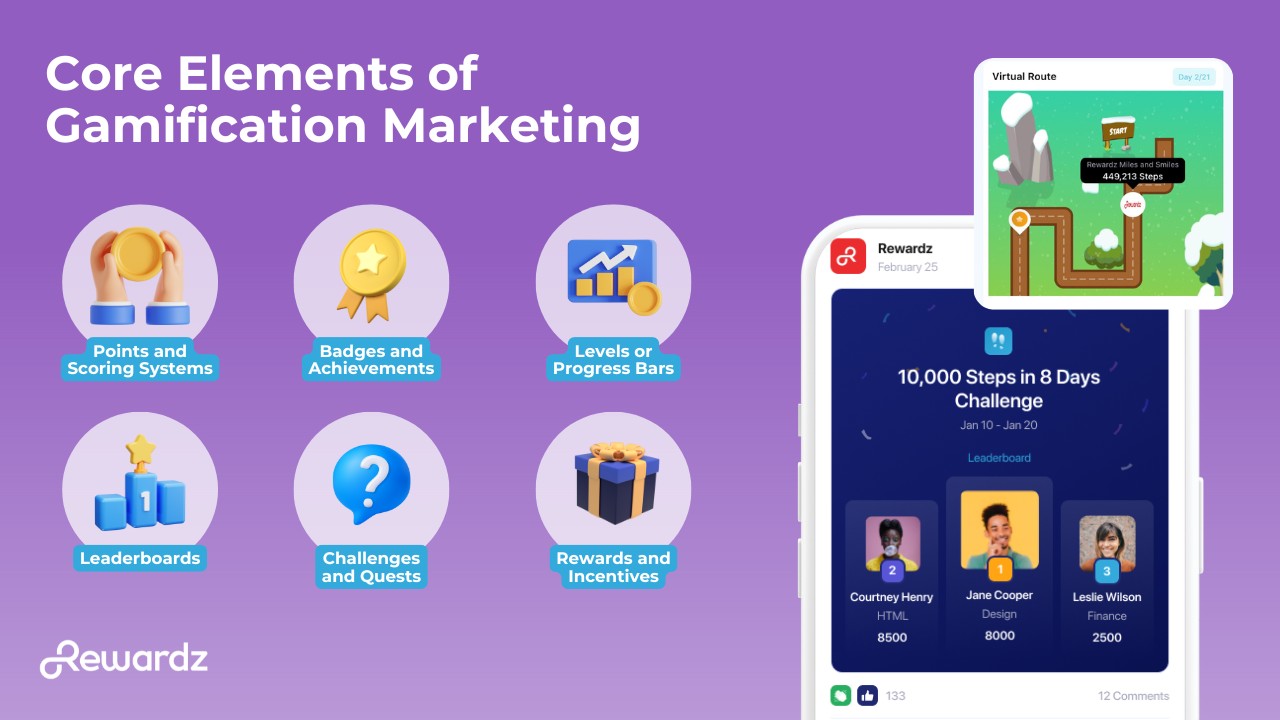When was the last time you checked your fitness app’s streak, collected points for a coffee purchase, or spun a wheel for a discount? These seemingly simple interactions represent a powerful marketing approach that turns everyday transactions into engaging experiences. Gamification has moved from a niche tactic to a mainstream strategy, reshaping how brands connect with their audiences.
What Is Gamification Marketing?
Gamification marketing applies game design elements and mechanics to non-game contexts, specifically marketing campaigns and customer experiences. Rather than creating actual games, it incorporates elements such as points, badges, challenges, and rewards into marketing strategies to motivate specific behaviours and deepen customer engagement.
The concept extends beyond mere point collection. It creates structured systems that tap into fundamental human desires for achievement, recognition, and progress. When implemented effectively, gamification transforms routine interactions (purchasing products, engaging with content, or using services) into experiences that feel rewarding and purposeful.
How Gamification Works
The effectiveness of gamification stems from well-established psychological principles that influence human behaviour and decision-making.
Reward Systems
The human brain responds powerfully to rewards, releasing dopamine when we achieve goals or receive recognition. Gamification leverages this neurological response by providing immediate feedback and tangible rewards for desired actions. This creates positive associations with brands and encourages repeated engagement.
Progress Tracking
Visible progress indicators satisfy our innate desire for completion and advancement. When you can see how far you’ve come (through progress bars, levels, or achievement milestones), you’re more likely to continue. This is known as the “endowed progress effect,” where people who perceive they’ve already made progress towards a goal are more motivated to complete it.
Competition and Social Validation
Humans are inherently social creatures who seek comparison and validation from peers. Leaderboards, sharing achievements, and competitive challenges tap into this drive. The visibility of accomplishments provides social proof and status, motivating participants to maintain or improve their standing.
Loss Aversion
Research in behavioural economics demonstrates that people are more motivated to avoid losses than to acquire equivalent gains. Gamification exploits this through mechanics like streaks, limited-time offers, or expiring rewards. The fear of losing progress or missing out creates urgency and sustained engagement.
Benefits of Gamification Marketing
The strategic application of gamification delivers measurable benefits across multiple marketing objectives.
1. Boosts Engagement
Gamified experiences capture and maintain attention more effectively than traditional marketing approaches. Research by Rhapsody Media indicates that gamification can increase engagement by 48%, whilst a study by Gigya found that gamified websites see a 29% increase in user engagement. These interactions last longer and occur more frequently, creating more opportunities for brand messaging and relationship building.
2. Improves Customer Retention and Loyalty
Gamification creates sticky experiences that encourage customers to return. According to a study, gamification can increase customer retention by 30%. The combination of progress investment, reward anticipation, and habit formation makes customers less likely to switch to competitors. Loyalty programmes with gamified elements see significantly higher participation rates than traditional schemes.
3. Increases Conversions
By guiding users through structured journeys and rewarding specific actions, gamification effectively drives conversions. Studies show that gamified marketing campaigns can increase conversion rates by 15-25%. The combination of clear pathways, immediate rewards, and motivational elements reduces friction and encourages desired behaviours, whether that’s completing a purchase, sharing content, or providing information.
4. Enhances Brand Perception
Gamification positions brands as innovative, user-focused, and engaging. Interactive experiences create positive emotional associations and differentiate brands in crowded markets. Customers perceive gamified brands as more modern and customer-centric, strengthening overall brand equity.
Also read: Understanding Brand Loyalty and How to Strengthen It
Core Elements of Gamification Marketing

Effective gamification combines multiple mechanics to create compelling experiences. Understanding these building blocks helps you design systems that resonate with your audience.
1. Points and Scoring Systems
Points provide immediate, quantifiable feedback for actions and serve as the foundation for most gamification strategies. They create a sense of accumulation and progress, giving users a tangible measure of their engagement. Points can be redeemed for rewards or simply serve as status indicators.
2. Badges and Achievements
Badges act as visual representations of accomplishments, providing recognition and status. They appeal to our desire for collection and completion, often motivating users to pursue activities they might otherwise skip. Well-designed badge systems create clear goals whilst celebrating diverse types of engagement.
3. Levels or Progress Bars
Levels segment the user journey into manageable stages, making long-term engagement feel achievable. Progress bars visualise advancement, leveraging the completion bias that drives people to finish what they’ve started. Both mechanics provide clear indicators of where users stand and what comes next.
4. Leaderboards
Leaderboards introduce competitive elements by displaying user rankings. They motivate performance improvement and create aspirational goals based on peer achievement. However, they work best when segmented appropriately. Global leaderboards can discourage average performers, whilst friend-based or tiered leaderboards maintain motivation across skill levels.
5. Challenges and Quests
Structured challenges provide specific objectives with defined outcomes, creating focused engagement opportunities. They break larger goals into achievable tasks and introduce variety to prevent monotony. Limited-time challenges add urgency, whilst ongoing quests support sustained engagement.
6. Rewards and Incentives
Tangible rewards like discounts, exclusive access, or physical prizes, provide extrinsic motivation for participation. The most effective reward systems balance immediate small rewards with aspirational larger prizes, maintaining motivation across different engagement levels. Virtual rewards (badges, status) complement material incentives by providing psychological satisfaction.
How to Implement Gamification in Marketing
Strategic implementation requires careful planning and ongoing optimisation. These steps provide a framework for developing effective gamification strategies.
1. Set Clear Objectives
Define what you want gamification to achieve. Are you aiming to increase repeat purchases, boost social sharing, improve data collection, or enhance brand awareness? Clear objectives guide design decisions and provide metrics for success measurement. Different goals require different mechanics. Engagement objectives might emphasise streaks and challenges, whilst conversion goals might focus on progress-based rewards.
2. Know Your Audience
Understanding your audience’s motivations, preferences, and behaviours is fundamental. Different demographics respond to different game mechanics. Younger audiences might appreciate social competition, whilst professional audiences might prefer progress tracking and skill development. Research your customers’ gaming familiarity, competitive tendencies, and preferred reward types.
3. Choose the Right Game Mechanics
Select mechanics that align with your objectives and audience preferences. Don’t implement every possible element. Focus on those that serve your goals. A fitness brand might emphasise challenges and progress tracking, whilst a retail brand might prioritise points and rewards. Consider the complexity level that matches your audience’s engagement capacity.
4. Integrate Seamlessly into User Journey
Gamification should enhance, not disrupt, the customer experience. Integrate mechanics naturally into existing touchpoints and workflows. Users shouldn’t need extensive tutorials or feel forced to participate. The best gamification feels intuitive and adds value without creating additional friction.
5. Measure and Optimise
Establish key performance indicators aligned with your objectives and monitor them consistently. Track engagement metrics, conversion rates, retention statistics, and user feedback. Use A/B testing to optimise mechanics, reward structures, and communication. Gamification requires iteration. What works initially may need adjustment as users adapt or markets change.
6. Ensure Ethical and Sustainable Use
Gamification should enhance user experience, not manipulate behaviour in harmful ways. Avoid creating addictive patterns that exploit psychological vulnerabilities. Ensure rewards are attainable and valuable, maintaining trust through transparent rules and achievable goals. Consider long-term sustainability. Can you maintain the programme economically, and will users remain engaged over extended periods?
Real-World Examples of Gamification Marketing
These implementations demonstrate gamification’s versatility across industries and objectives.
1. Nike Run Club
Nike’s running app transforms exercise into a gamified experience with achievement badges, progress tracking, audio-guided runs, and social challenges. Users earn trophies for distance milestones, compete with friends, and receive personalised coaching. The app strengthens Nike’s brand association with athletic achievement whilst building a loyal community of engaged users who consistently interact with the brand.
2. Duolingo
The language learning platform masterfully combines multiple gamification elements: daily streaks, experience points, achievement badges, competitive leaderboards, and progression levels. Users receive immediate feedback, unlock new content through advancement, and maintain engagement through loss aversion (protecting their streak). This approach has helped Duolingo achieve over 500 million users whilst maintaining remarkably high retention rates for an education app.
3. McDonald’s Monopoly
This long-running campaign transforms purchasing into a game of chance and collection. Customers receive game pieces with purchases, creating immediate engagement and encouraging repeat visits to complete property sets. The campaign combines multiple motivators: potential for significant prizes, the thrill of chance, collection completion drive, and social sharing of rare pieces. McDonald’s reports significant sales increases during Monopoly periods.
4. KFC Japan Mobile Game Campaign
KFC Japan launched a mobile game called “Shrimp Attack” where players defended the Colonel from alien shrimp. High scores earned coupons redeemable at KFC restaurants. The campaign successfully drove foot traffic whilst creating entertaining brand interactions. By making the game genuinely enjoyable rather than purely promotional, KFC generated organic social sharing and extended brand engagement beyond traditional advertising.
5. Grab Rewards
Users earn points for every ride, food order, or delivery, redeemable for discounts or partner rewards. The tiered system (Member, Silver, Gold, Platinum) encourages consistent usage and customer loyalty. Higher tiers unlock additional benefits like priority support and exclusive offers, motivating users to consolidate their spending within the Grab ecosystem rather than splitting between competitors.
6. Shopee’s In-App Games
Daily games like Shopee Shake and Shopee Farm reward users with coins or vouchers, boosting app engagement and repeat visits during campaigns like 11.11 and 12.12. These simple but addictive games create daily habits, with users returning specifically to play even when not shopping. The coins earned encourage purchases by providing immediate discounts, effectively converting engagement into transactions.
7. DBS Lifestyle App (DBS PayLah!)
This app introduces gamified challenges such as cashback missions (“Spend 3 times this week to earn rewards”), driving higher transaction frequency and app engagement. By framing banking activities as achievable challenges with clear rewards, DBS transforms routine financial transactions into goal-oriented activities. The approach successfully increases both transaction frequency and digital service adoption.
Also read: 20 Impactful Loyalty Program Examples You Can Learn From
Challenges and Best Practices
Whilst gamification offers significant benefits, implementation presents specific challenges that require careful consideration. Understanding these obstacles and applying proven strategies ensures your gamification efforts deliver sustainable results rather than short-lived novelty.
Common Challenges
Implementing gamification isn’t without its pitfalls. Even well-intentioned programmes can falter if these critical challenges aren’t addressed from the outset.
- Over-complication creates barriers to entry. Systems with too many mechanics, complex rules, or confusing interfaces overwhelm users and discourage participation. When users need extensive tutorials just to understand how to earn points or what badges mean, you’ve lost the intuitive appeal that makes gamification effective. The solution lies in keeping mechanics straightforward and introducing complexity gradually as users become comfortable with the basics.
- Motivation decline happens when novelty fades. Users often engage enthusiastically at launch but lose interest once they’ve achieved primary objectives or when challenges become repetitive. The initial excitement of earning your first badge or reaching a new level diminishes with familiarity. Without evolution, gamification becomes just another routine task rather than an engaging experience. Combating this requires regular content updates, seasonal variations, and evolving challenges that maintain freshness.
- Technical complexity can derail execution. Gamification requires robust infrastructure to track user actions, calculate points, trigger rewards, and display progress in real-time. Underestimating these technical requirements leads to buggy experiences that frustrate users, delayed launches that miss market opportunities, and ongoing maintenance headaches. The investment in proper development expertise and infrastructure is substantial but non-negotiable for smooth operation.
Best Practices for Long-Term Success
Avoiding these challenges requires more than awareness. It demands deliberate strategies that prioritise user experience and sustainable design. These practices form the foundation of gamification programmes that maintain engagement well beyond initial launch.
- Start simple and iterate based on evidence. Launch with core mechanics that deliver clear value, then expand thoughtfully based on user feedback and behavioural data. This approach reduces initial complexity, allowing users to engage without overwhelm, whilst giving you the opportunity to learn from real behaviour before committing to additional features. A points system with basic rewards teaches you what motivates your audience before you invest in elaborate leaderboards or complex achievement trees.
- Balance extrinsic rewards with intrinsic satisfaction. Don’t rely solely on points and prizes to drive engagement. Create experiences that are inherently enjoyable, valuable, or aligned with user goals, with rewards enhancing rather than replacing this intrinsic motivation. When users participate primarily for rewards, engagement collapses if those rewards decrease. When they participate because the experience itself is worthwhile, rewards amplify existing motivation rather than creating dependency.
- Refresh content strategically to sustain interest. Regular updates, seasonal events, and new challenges prevent the stagnation that kills motivation over time. Plan content calendars that introduce variety whilst maintaining familiar core mechanics users have already mastered. This might mean rotating challenges monthly, introducing limited-time events tied to holidays or cultural moments, or gradually unveiling new achievement categories that reward different types of engagement.
Beyond the Game: Gamification as Strategic Advantage
One of the most critical components of successful gamification is the rewards system itself. Whilst game mechanics drive engagement, the rewards must deliver real value to sustain long-term participation. This is where having a flexible, scalable rewards infrastructure becomes essential.
SPUR offers a comprehensive solution for implementing robust rewards programmes within your gamification strategy. With access to digital gift card solutions from over 2,000 partners across 30+ countries, you can provide rewards that resonate with diverse audiences and preferences. Whether your users prefer dining vouchers, retail discounts, entertainment options, or travel rewards, the breadth of options ensures meaningful incentives for different segments.
The platform’s Reward and Redemption APIs integrate seamlessly into your existing systems, allowing you to embed rewards directly into your gamified experiences without building infrastructure from scratch. This integration capability means you can focus on designing engaging game mechanics and user experiences, whilst the technical complexity of reward fulfilment, inventory management, and redemption tracking is handled through a proven solution.
For brands looking to implement or enhance their gamification strategies, having a reliable rewards partner eliminates one of the major implementation challenges we discussed earlier. Instead of negotiating with dozens of reward suppliers, managing multiple integrations, or worrying about reward availability and delivery, you can access a comprehensive catalogue through a single integration point.
Ready to build a gamification strategy with rewards that truly motivate? Get in touch with us to explore how SPUR can power your rewards programme and help you create the engaging, loyalty-building experiences your customers will value.



